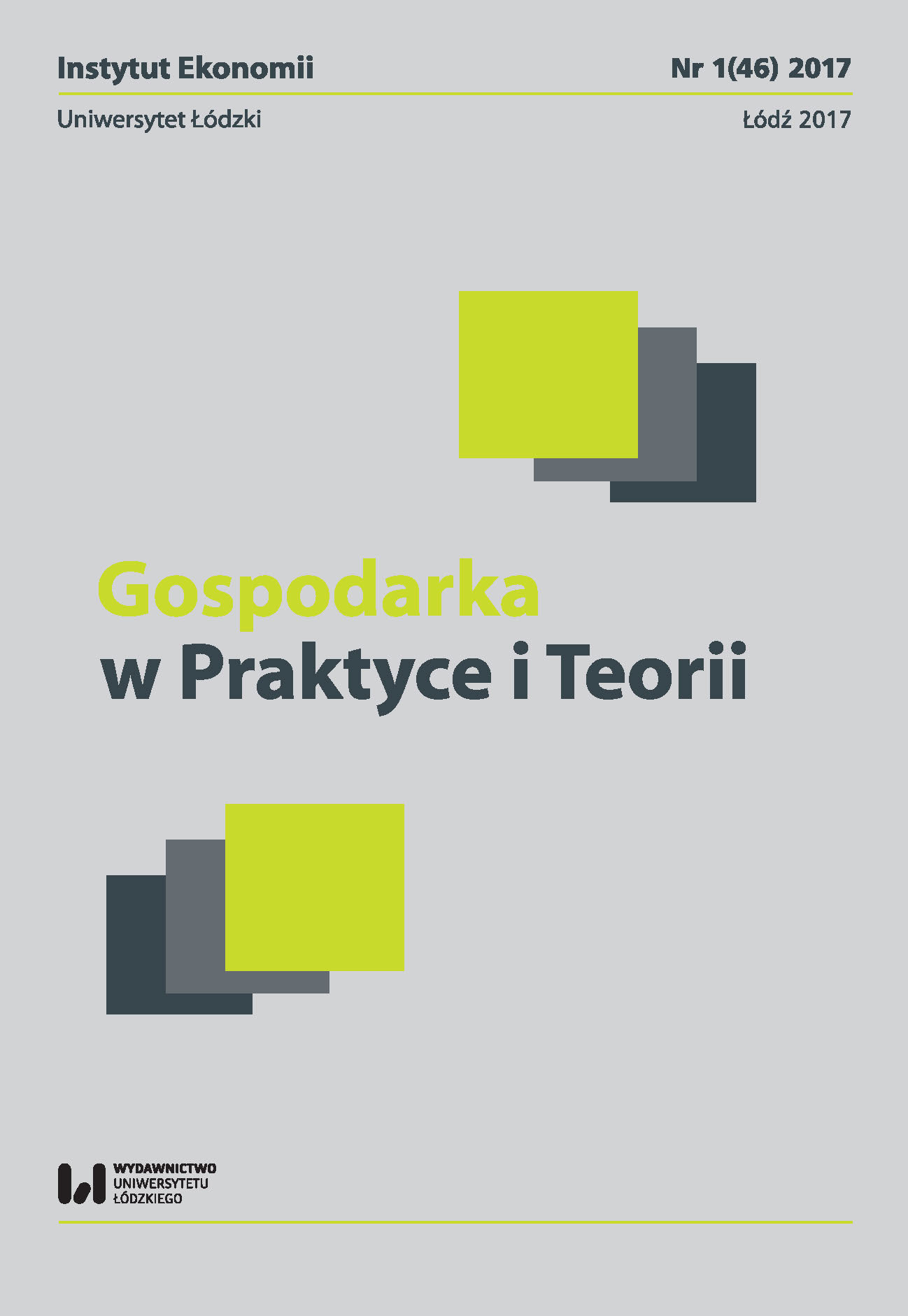Financial aid for Eurozone countries taken in response to debt crisis
DOI:
https://doi.org/10.18778/1429-3730.46.04Keywords:
financial crisis, Eurozone, financial aid, mortgage bubbleAbstract
Crisis which began in 2007 in the United States caused problems in some Eurozone countries. Due to low interest rates and cheap credit mortgage bubble was inflated. Many international financial institutions were strongly engaged in home loans market and market of derivatives linked with mortgages, so when mortgage market in USA broke down many of those institutions lost financial stability and some of them bankrupted. Investors retreated their capital from risky instruments and several bonds and put it in more secure assets. It caused credit crunch and liquidity crunch in international financial markets, which had impact on financial situation of some European countries. Good example is Greece budget was strongly basing on cheap loans, so when liquidity crunch occurred they appeared in shadow of bankruptcy. Other countries like Ireland or Spain had problems due to their own mortgage bubbles and their budgets broke because they had to rescue financial institutions. European Union created several instruments to help those countries along with IMF, but not in all cases assistance was well used. Ireland came back to way of prosperity, but Greece is still struggling to avoid bankruptcy and their budget is way off balance. It would be better if European countries abandoned their political objectives, let Greece broke and come back to drachma to avoid endless loses and, in the long run, lower uncertainty on the market.
References
Biuro Pełnomocnika Rządu ds. Wprowadzenia Euro przez Rzeczpospolitą Polską, Ministerstwo Finansów, Co to jest EFSF i ESM?, www.mf.gov.pl/documents/764034/1417826/23_efsf-esm.pdf [dostęp: 21.06.2016].
Google Scholar
Brunnermeier M.K., Deciphering the Liquidity and Credit Crunch 2007–2008, Journal of Economic Perspectives, 23, 1 – Winter 2009.
Google Scholar
Buszko M., Rynek produktów strukturyzowanych CDO w warunkach światowego kryzysu finansowego, Acta Universitatis Nicolai Copernici, Ekonomia XLI – Nauki Humanistyczno-Społeczne, Zeszyt 397, Toruń 2010.
Google Scholar
Chudik A., Fratzcher M., Identifying The Global Transmission of the 2007–09 Financial Crisis in a GVAR Model, ECB Working Paper Series No. 1285, 2011.
Google Scholar
Ehrenberg, B., CITY A.M., Grexit from the euro means Greece will also have to leave the EU says Martin Schulz, as Athens claims ball is in creditors’ court, 18.06.2015, http://www.cityam.com/218262/grexit-euro-means-greece-will-also-have-leave-eu-says-martin-schulz-athens-says-ball [dostęp: 13.07.2016].
Google Scholar
European Central Bank, Monthly Bulletin, November 2003.
Google Scholar
Federal Reserve of San Francisco, The Subprime Mortgage Market. National and Twelfth District Developments, Annual Report, 2007.
Google Scholar
Gabrielczak P., Rola kanału handlowego i finansowego w zarażeniu państw rozwiniętych i rozwijających się, Studia i prace Wydziału Nauk Ekonomicznych i Zarządzania, 3(41), 2015.
Google Scholar
Golańska-Płuciennik M., Kryzys w Hiszpanii, [w:] Kryzys i perspektywy strefy euro, red. J. Rymarczyk, M. Wróblewski, D. Brzęczek-Nester, Międzynarodowe Stosunki Gospodarcze. Aktualne Problemy VIII, Wrocław 2014.
Google Scholar
Grabińska B., Pomoc finansowa dla państw strefy euro dotkniętych kryzysem zadłużenia, Zeszyty Naukowe Uniwersytetu Ekonomicznego w Krakowie, 8(932), 2014.
Google Scholar
Grabowski W., Stawasz E., Determinanty rentowności obligacji skarbowych peryferyjnych krajów strefy euro w warunkach stabilności i kryzysu, Bank i Kredyt, 47(2), 2016.
Google Scholar
International Monetary Fund, Spain: Selected Issues, IMF Country Report No. 11/216, 2011.
Google Scholar
Kennedy G., McIndoe-Calder T., The Irish Mortgage Market: Stylised Facts, Negative Equity and Arrears, Central Bank Quarterly Bulletin, Central Bank of Ireland, January 2012.
Google Scholar
Koczor M., Analiza tymczasowych rozwiązań ratunkowych/stabilizacyjnych przyjętych w strefie euro od 2010 roku, [w:] Hereditas Mercaturae, red. P. Czubik, Z. Mach, Instytut Multimedialny, Kraków 2012.
Google Scholar
Lubiński M., Międzynarodowa transmisja koniunktur a zarażenie, [w:] Nowe oblicza cyklu koniunkturalnego, red. R. Barczyk, L. Kąsek, M. Lubiński, K. Marczewski, Polskie Wydawnictwo Ekonomiczne, Warszawa 2016.
Google Scholar
Michalski B., Kryzys irlandzki. Jak i dlaczego celtycki tygrys stracił swoją drapieżność?, [w:] Kryzys i perspektywy strefy euro, red. J. Rymarczyk, M. Wróblewski, D. Brzęczek-Nester, Międzynarodowe Stosunki Gospodarcze. Aktualne Problemy VIII, Wrocław 2014.
Google Scholar
Mizen P., The Credit Crunch of 2007–2008: A Discussion of the Background, Market Reactions, and Policy Responses, Federal Reserve Bank of St. Louis Review, 90(5), September/October, 2008.
Google Scholar
Narodowy Bank Polski, Informacja na temat nowych zasad funkcjonowania Europejskiego Instrumentu Stabilności Finansowej (EFSF) oraz przyszłego kształtu Europejskiego Mechanizmu Stabilności (ESM), Warszawa, sierpień 2011.
Google Scholar
Strona internetowa Europejskiego Instrumentu Stabilności Finansowej, http://www.efsf.europa.eu [dostęp: 16.06.2016].
Google Scholar
Strona internetowa Europejskiego Mechanizmu Stabilności, http://www.esm.europa.eu [dostęp: 16.06.2016].
Google Scholar
Strona internetowa Komisji Europejskiej, http://ec.europa.eu [dostęp: 16.06.2016].
Google Scholar
Traktat o Unii Europejskiej.
Google Scholar
http://ec.europa.eu/economy_finance/eu_borrower/efsm/index_en.htm [dostęp: 16.06.2016].
Google Scholar
http://www.efsf.europa.eu/about/operations/index.htm [dostęp: 16.06.2016].
Google Scholar








